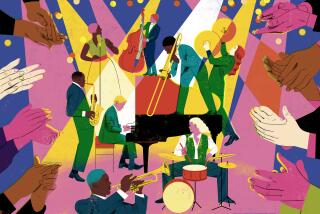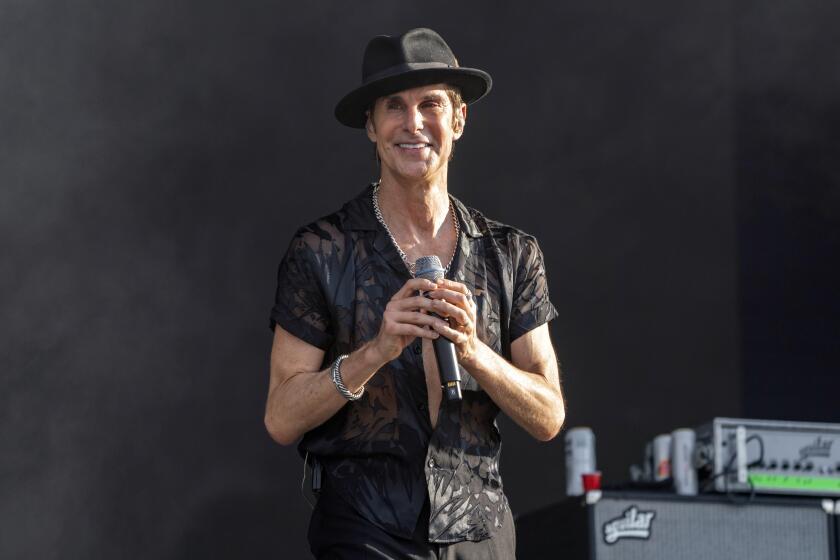Spreading the Jazz Gospel of Thelonious Monk : THE LEGACY : At Duke University, the legend lives on as the next generation of musicians is exposed to Monk’s musical ideals
DURHAM, N.C. — Long identified with tobacco and--since the movie “Bull Durham”--with minor league baseball, this city is moving to become a major jazz mecca with the drive to build the Thelonious Monk Institute of Jazz, affiliated with Duke University.
“We’ve become one of the more talked-about places in jazz,” said Paul H. Jeffrey, a saxophonist and longtime Monk associate now teaching at Duke. Despite his role as a driving force in the jazz explosion, the astonished Jeffrey said “I don’t know how that happened myself.”
Monk, the gifted pianist and composer known as “the High Priest of Bebop,” died in 1982 at the age of 63. Best known for “ ‘Round Midnight” and “Brilliant Corners,” he is the subject of a new 90-minute documentary, “Thelonious Monk: Straight No Chaser.”
When plans for the institute were announced in 1988, Thelonious Monk Jr., 39, a Brooklyn, N.Y., drummer, characterized the project as a step toward “collectively carrying on the sincere commitment that Thelonious Monk made to young musicians. It is historically appropriate that the institute be located in Durham, and affiliated with Duke, for Thelonious was born less than 100 miles away in Rocky Mount, N.C.”
The ultimate goal of the institute, said Thomas R. Carter, the executive director, is nothing less than producing “a whole new generation of jazz musicians.”
“We’re looking to turn out players, “ Monk said. Together with the institute and the documentary, he said, his father’s music has recently enjoyed “almost a second, cult coming. He was always seen to be a conduit, a center of the universe. People always seemed to pass through Thelonious Monk on their way to higher ground--and the institute is just a natural extension of that.”
The Monk Institute will be a four-year, independent institution accredited by the National Assn. of Schools of Music and will grant performance degrees, according to Carter. The first class of 35-40 students is scheduled to enter in 1992. Earlier this week, Monk and Carter met with USC officials to explore the additional possibility of having Monk Institute students spend a year of study in Los Angeles.
Current plans call for a three-building complex in Durham, one of which is a 70,000-square foot academic facility, including classrooms, a library with Monk’s papers and a museum with his instruments, rehearsal halls, a recording studio and 500-seat performance hall. The remainder of the $12-million complex would be a student dormitory and living accommodations for visiting faculty. An architectural design competition for the institute is under way at Howard University in Washington, D.C., and ground is scheduled to be broken within 18 months.
Durham city and county have enthusiastically embraced the institute, appropriating $750,000 to purchase a 1.62-acre site in the downtown area earlier this year. Mayor Wib Gulley called the institute the city’s “crowning touch” of artistic activity, complementing a new arts center near the site, which includes the restored, 1,200-seat Carolina Theatre, nearby convention center and Omni Hotel.
An endowment of $50 million, enabling many of the estimated 150 students to attend tuition-free, is also planned. Most of the funds will come from private and corporate sources, said Jeffrey, who also serves as vice chairman of the institute’s academic council, but additional help from the city, county and state, as well as Duke, are also expected. Between $500,000 and $1 million has been raised so far, school officials say. Proceeds from this year’s 3rd annual Thelonious Monk International Jazz Competition held this weekend in Washington, D.C., are earmarked for the conservatory.
Last January, a concert at Duke to “introduce” the institute to the community featured Steve Allen and Jayne Meadows, Clint Eastwood--executive producer of “Straight No Chaser”--Clark Terry, Percy Heath and Thelonious Monk Jr. Three months later, a fund-raising concert at the Omni featuring Dizzy Gillespie and Wynton Marsalis and hosted by Bea Arthur and Rue McClanahan of NBC’s “Golden Girls” drew 900 people to the campus.
Beginning this January, the institute will be kicking off a two-year series of fund-raising concerts in New York, Los Angeles, London and Tokyo, Carter said. The goal, Monk said, is to raise money from the corporate and private sector, including the broader community of jazz lovers.
A partial list of members of the institute’s advisory board reads like a Who’s Who of jazz aficionados from the worlds of music, sports, entertainment and politics: Art Blakey, Wynton and Branford Marsalis, Jimmy and Percy Heath, Herb Alpert, Dizzy Gillespie, Kareem Abdul-Jabbar, Bill Cosby (honorary chairman), Debbie Allen, Billy Dee Williams, Marla Gibbs, U.S. Sens. Robert Dole and Wyche Fowler, former Atlanta Mayor Andrew Young and Martin Luther King III.
“By getting the community outside the musicians excited, the musicians have become excited,” Monk said. “It has snowballed. It has become so real in the minds of the artists in this medium. It’s important for America . . . When we came up with the idea of building a school it just seemed to be appropriate to absolutely everyone. There was a tremendous hunger out there for something like this. We have structure. What we’re doing is unlike a lot of things in jazz. It’s become believable. It seems do-able, plainly do-able to everyone involved.”
The idea of a jazz conservatory, Jeffrey said, grew out of an observation read at Monk’s 1982 funeral by jazz historian and critic Ira Gitler, that Thelonious Monk’s stature in the jazz community paralleled that of Beethoven in classical music, because he was a maverick genius.
That observation piqued the interest of Maria Fisher, founder of the Beethoven Society, when some Monk cousins approached her in Rocky Mount, N.C., where Fisher was hosting a society event. She took up the idea of creating a “living, vibrant memorial surrounding Thelonious’ name,” said Carter, who was then the Beethoven Society’s executive director. “From this it evolved from a project to honor Thelonious Monk to the first conservatory in the world for jazz musicians,” he said.
Carter eventually took on the position as executive director of the Monk Institute along with his duties with the Beethoven Society.
“It’s amazing how small this idea began,” said Monk. “It was very modest.” But “right after the idea began to fly,” Monk said, he signed up to be the institute’s “chief fund-raiser and front man,” putting aside his own career as a jazz and rhythm and blues recording artist to become chairman of the institute. Since then, he said, the effort has “consumed my life.”
After a preliminary search for sites that included Rocky Mount, Durham, New Orleans, Philadelphia, Washington, D.C., Detroit and Los Angeles--both USC and UCLA were considered--attention returned to Durham and to Duke.
Over the past dozen years, Duke had quietly been turning itself into “Jazz U,” picking on an earlier tradition that included undergraduates Les Brown, Pat Williams and Sonny Burke. In 1977, Frank Tirro, then chairman of the music department and later author of “Jazz: A History,” invited pianist, composer and arranger Mary Lou Williams, known as “the Queen of Jazz,” to become the university’s artist-in-residence.
Williams taught a perennially oversubscribed history of jazz course, as well as individual tutorials, and composed several masses for All-Saints Day services in Duke’s soaring Gothic chapel. At graduation ceremonies in the spring of 1981, days before her death, she received the university’s Trinity Award for “significant service to the university and to humanity.” Later, a campus black cultural center was named in her honor. A plaque on the wall reads “Dedicated to the memory of Mary Lou Williams, who lived music and loved people.”
An annual Mary Lou Williams Jazz Festival was also established on the campus in 1983. That same year, Paul Jeffrey joined the Duke faculty after commuting from Rutgers University to teach part time in the music department.
“I came down to teach the jazz history class and fell in love with the campus and Duke University,” Jeffrey said last month, before a Mary Lou Williams festival concert featuring McCoy Tyner. Today, Jeffrey teaches full time, and despite a shoestring budget the Jazz Studies program attracts more than 200 students in one capacity or another, including the Duke Jazz Ensemble, which Jeffrey leads.
By the time Monk and Carter came to take another look at Durham as a home for the institute, Jeffrey and other boosters had lined up key local allies. Chief among these was heiress Mary Duke Biddle Trent Semans, a Duke family descendant and university trustee, as well as the strong-willed fairy godmother of nearly every good cause in North Carolina.
“She never let up,” Carter said. “She brought in a very heavy lobbying effort,” including Republican Gov. James G. Martin and Democratic U.S. Sen. Terry Sanford, who is also a former Duke president.
Semans, whose foundation helped underwrite both the cultural center and jazz festival named for Mary Lou Williams, then arranged a meeting with Duke’s president, H. Keith H. Brodie, for herself, Jeffrey, Monk and Carter, where the group had quite a surprise.
“We literally fell out of our chairs,” Jeffrey recalled, when Brodie said that he was familiar with Thelonious Monk’s music. “He named a particular record and said that that was one of the records that started him listening to jazz,” Jeffrey said.
Brodie assured them that he “wholeheartedly supported the project,” Jeffrey said. “He said that presidents like to leave a legacy. He said he would like to, as his legacy, be able to say that the first jazz conservatory--full-fledged jazz conservatory in this country--was affiliated with Duke University.”
“Duke University really wanted it for the right reasons,” Monk said. “Some institutions wanted it because of the high profile, the glitter. But this thing is really about education. That’s what Duke and Brodie were interested in.”
Another thing that made Durham attractive, Carter added, was that it was away from the potential distractions of too many clubs and agents in some big cities like Los Angeles.
“It was more of a Tanglewood environment,” Carter said, referring to the summer music festival in Massachusetts, a place that “would enable the students to totally concentrate on their music.”
“Duke University is perfect,” Monk said. “The Carolinas are perfect. If you want to learn you have to be in a learning environment. We have to create the kind of environment where you eat and sleep jazz . . . It’s important to us that we had a place where our students couldn’t be immediately whisked away by the industry. You don’t want to lose your students before they graduate.”
The details of the relationship between Duke and North Carolina Central University--a historically black state school in Durham--have yet to be worked out, but as Jeffrey envisions it, Monk students could take non-music courses at Duke and North Carolina Central, and Duke students could take non-performance courses at Monk and at North Carolina Central.
“I feel very comfortable landing in Durham,” said Monk. “Thelonious was born in North Carolina. I know that sounds corny, but the setting is right. The respect begins sometimes with the location. It’s a wonderful educational environment. The environment is ideal.”
More to Read
The biggest entertainment stories
Get our big stories about Hollywood, film, television, music, arts, culture and more right in your inbox as soon as they publish.
You may occasionally receive promotional content from the Los Angeles Times.










